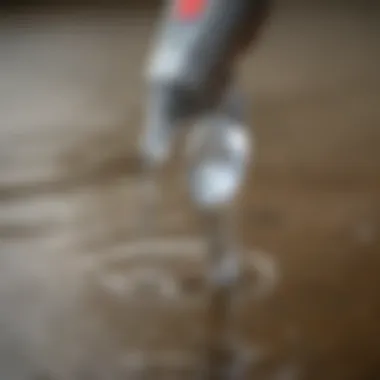Effective Strategies to Remove Water from the Ear


Intro
Water trapped in the ear can be a bothersome experience, especially for those who spend time in the water, whether it's swimming, diving, or even just bathing. It's all too common to feel the annoying sensation of fluid stuck in the ear canal after a plunge into a pool or a splash from a wave. Understanding how to deal with this issue not only improves comfort but also enhances safety during water activities.
In this article, we’ll explore comprehensive strategies for eliminating that pesky water, covering both home remedies and professional interventions. We'll delve into techniques that can help alleviate the discomfort, focusing on practical approaches that anyone can implement. Furthermore, we’ll highlight key preventive measures, ensuring that water sports enthusiasts can enjoy their activities without the looming threat of ear complications.
Being armed with the right knowledge can make a world of difference. Before we dive into the effective strategies, let’s set the stage by discussing some gear recommendations.
Understanding the Issue
Water trapped in the ear can turn an otherwise delightful day at the beach or pool into a remarkable nuisance. For athletes and outdoor enthusiasts alike, this phenomenon is more than just an annoyance; it can interfere with concentration and performance. Understanding why this occurs is crucial for effective management and prevention.
When water becomes lodged in the ear, it can lead to uncomfortable sensations, muffled hearing, and even infections if left unchecked. Recognizing the anatomical features of the ear and the physiological mechanics at play can help individuals better navigate their water activities without the constant worry of discomfort.
Here, we will dissect the anatomy of the ear and delve into the reasons why water gets trapped inside, shedding light on how to tackle the issue effectively.
The Anatomy of the Ear
To grasp how water becomes trapped, one must first understand the ear's anatomy. The ear consists of three main parts: the outer ear, middle ear, and inner ear.
- Outer Ear: This includes the visible portion, known as the pinna, which collects sound waves and directs them into the ear canal.
- Middle Ear: Inside the ear canal lies the eardrum, beyond which are the ossicles—a chain of tiny bones that amplify sound vibrations.
- Inner Ear: This area is responsible for converting these vibrations into signals that our brain interprets as sound. The inner ear also houses structures that play critical roles in balance.
A clearer understanding of this anatomy highlights why water can sometimes get stuck after swimming or showering. The shape of the ear canal, often described as an L-shaped tube, can create pockets where water may linger, particularly if the head is tilted or if there’s excess earwax present that can make drainage difficult.
Why Does Water Get Trapped?
Several reasons lead to water becoming trapped, and knowing these can help in addressing the problem.
- Anatomical Shape: As previously mentioned, the L-shaped ear canal means that, depending on how one is positioned, water can easily get trapped when one is immersed in water.
- Earwax Buildup: Earwax, though natural and protective, can block the path of water, preventing it from draining out effectively. If someone has excessive wax, it may not only trap water but also promote irritation.
- Pressure Changes: Rapid altitude changes can create pressure imbalances that might cause water to stay put. This is common during air travel or diving, where the body may not equalize pressure quickly enough.
- Swimming Technique: How individuals swim can also play a role. For instance, freestyle swimmers often turn and tilt their heads, making it easier for water to flow into the ear canal and become lodged.
"Water trapped in the ear may seem trivial initially, but understanding its causes can prevent discomfort and potential complications later on."
Overall, recognizing the reasons behind this common issue will allow athletes and adventurers to take proactive measures, keeping their ear health top of mind and ensuring that they can fully enjoy their aquatic pursuits.
Common Symptoms of Water in the Ear
Understanding the symptoms of water trapped in the ear is crucial for timely intervention and relief. Athletes and outdoor enthusiasts often find themselves in situations where water can easily seep into the ear canal. Recognizing the signs early helps prevent discomfort from escalating into more serious complications. To simplify matters, let’s delve into the two primary facets of symptoms that can arise from this issue: the physical sensations experienced and potential health risks.
Recognizing Discomfort
When water becomes lodged in the ear, the first and most common symptom is a feeling of fullness or pressure. This can be likened to the sensation of having a heavy weight hanging on the eardrum. You might also experience muffled hearing; sounds can seem distant or muted, creating a frustrating barrier between you and your surroundings.
Another common complaint is a tickling or itching sensation, often accompanied by a desire to shake the head or tilt it to one side in hopes of dislodging the water. This discomfort can vary from mild annoyance to outright irritation, making it difficult to concentrate on other activities.
In some instances, you might hear a sloshing sound as you move your head. This auditory cue serves as a reliable reminder that the water is still trapped. It’s a little like hearing a half-filled bottle of water being shaken; it can be hard to ignore. If you notice these symptoms, you’re likely dealing with water caught in your ear, and it’s worth paying attention to before it leads to further issues.


Potential Risks of Trapped Water
While water doesn’t seem hazardous at first blush, leaving it trapped in the ear can lead to complications. One of the primary concerns is the risk of ear infections. The moisture creates an ideal breeding ground for bacteria, increasing the likelihood of an outer ear infection, commonly known as swimmer's ear. Symptoms of an infection might include intense pain, swelling of the outer ear, and even drainage of fluid that might be accompanied by foul odors.
Additionally, prolonged water retention can sometimes lead to more complex issues, such as inflammation. Inflammation of the outer ear canal can make you more sensitive to sounds and may cause discomfort that persists even after the water is removed. This situation can interfere with activities that require acute hearing, such as sports or outdoor instructions, making it paramount to address any symptoms promptly.
"Prompt recognition of symptoms can be the key to preventing complications from water trapped in the ear. Ignoring them can spell trouble in your adventures outdoors."
In summary, being aware of the discomfort caused by trapped water and its potential risks is essential, especially for those who regularly engage in water activities. By recognizing these symptoms, one can take appropriate and timely action to avoid further complications.
Home Remedies to Remove Water from the Ear
Water stuck in the ear can be quite bothersome, especially for those who enjoy aquatic adventures. Instead of turning immediately to a medical professional, many find solace in home remedies. These solutions can be effective, accessible, and economical, making them a practical choice for athletes, instructors, and hobbyists alike. By trying out some straightforward methods, individuals can facilitate the removal of trapped water while also learning important ear care practices.
Gravity Techniques
One of the simplest and most common approaches to remove water from the ear is using gravity. This method leverages the natural pull of gravity to encourage the trapped liquid to flow out. Here’s how to try it:
- Tilt Your Head: Lean your head to the side — the affected ear facing downward. This can sometimes be effective simply through positioning.
- Jump or Shake: To enhance the effect, you might try jumping on one leg or shaking your head gently. This can help create a movement that might dislodge the trapped water.
- Jiggling Jaw: Open and close your mouth while tilting your head. This can create pressure changes, helping to draw the fluid outwards.
"Gravity’s not just a good idea for falling apples; it’s also a tool for getting water out of your ear."
Using Heat and Steam
Applying heat can also be an effective technique for relieving water trapped in the ear. The warmth can help evaporate the moisture. Here’s a practical way to adopt this strategy:
- Warm Cloth: Take a clean cloth and soak it in warm water. Wring it out so it’s damp but not dripping. Place this cloth against the ear – it's soothing and works as a gentle heat source.
- Steam Inhalation: You can also use steam to help open up the Eustachian tubes, which could facilitate drainage. Sitting in a bathroom with a hot shower running can create steam. Just breathe normally, letting the steam fill your nasal passages, and it may help to clear the ear as well.
Vinegar and Alcohol Solution
A mixture of vinegar and rubbing alcohol can be an effective solution for removing trapped water. Vinegar helps prevent bacteria growth, while alcohol can help dry out any leftover moisture. Here’s how to make and use this remedy:
- Mix the Solution: Combine equal parts of white vinegar and rubbing alcohol in a small container.
- Application: Using a dropper, place a few drops of this solution into the affected ear. Allow it to sit for about 30 seconds to a minute.
- Drain: After waiting, tilt your head once more to let it drain out, along with any trapped water.
While these remedies are generally safe, individuals should always be cautious and use them wisely. If any discomfort arises or the sensation of water does not improve, seeking professional advice may become necessary. Taking preventive measures to avoid water trapping in the first place will make all the difference for passionate adventurers.
Professional Methods for Treatment
When water finds itself lodged in the ear, it can lead to discomfort that lingers long after a day of fun in the water. While home remedies often provide relief, sometimes pro methods are the best way to tackle the issue effectively. Understanding the significance of professional methods is crucial for those who frequently engage in water activities such as swimming, surfing, or diving. In this section, we will delve into some key professional approaches that can ensure your ears are free from stubborn water and any potential complications.
The benefits associated with seeking professional intervention cannot be understated. These methods are generally more reliable and might be necessary if home remedies fall short. Consulting with an expert not only provides relief but also safeguards against infections or other complications that can arise from prolonged water retention. A trained ear, nose, and throat specialist has the requisite expertise to evaluate your condition accurately and offer tailored treatments.
Ear Irrigation Techniques
Ear irrigation is a method employed by healthcare providers to flush out trapped water. This procedure is typically performed using a gentle stream of warm, sterile water that is designed to break the surface tension of the water trapped within the ear canal.


- The Process
- First, the specialist examines the ear to ensure there are no existing injuries or infections.
- Next, a syringe or an irrigation device is used to introduce water at a low pressure.
- After irrigation, the practitioner often employs suction to remove the accumulated water along with any dislodged earwax, ensuring a clear ear canal.
While this technique is generally safe, it is important to note that individuals with certain conditions, such as perforated eardrums, should avoid this treatment.
Suction and Aspiration Procedures
Suction and aspiration procedures are more invasive than ear irrigation but can be very effective, especially when water is trapped deep within the ear canal.
During a suction procedure:
- The healthcare provider uses a specialized instrument designed to create a vacuum effect.
- This vacuum pulls the trapped water out without the risks associated with the use of large amounts of fluid in ear irrigation.
Suction methods may also help clear debris or earwax, which can contribute to discomfort. This technique requires skill and strict sanitation protocols to prevent potential complications like infection.
Consulting an Ear Specialist
When all else fails, or if symptoms worsen, consulting an ear specialist is a prudent course of action. These healthcare professionals offer invaluable insights and treatments tailored to individual needs. When visiting an ear specialist, one can expect:
- A thorough examination using an otoscope to evaluate the condition of the eardrum and ear canal.
- A comprehensive discussion about symptoms, including duration and any discomfort experienced.
- Tailored recommendations based on the individual’s specific needs and underlying conditions.
An expert can also rule out more severe issues that might mimic the sensation of trapped water, ensuring peace of mind.
Always prioritize safety and health over convenience when it comes to ear care.
Preventive Measures to Avoid Water Trapping
Water trapped in the ear can lead to discomfort, and even potential infections if not handled properly. While various methods exist to relieve this issue, taking preventive measures can save you a lot of trouble. Not only do these practices help in reducing the likelihood of water becoming lodged in your ear, but they also promote general ear health. Here’s a closer look at some effective strategies to keep water from causing a fuss in your ears.
Using Earplugs While Watersports
For those who enjoy splashing around in pools or oceans, using earplugs can be a game changer. High-quality silicone or moldable earplugs create an effective barrier against water entering the ear canal. Some folks might prefer custom-fitted earplugs for optimal comfort. They don’t just keep water out; they also help block out noise, allowing for a more peaceful experience while you swim or surf.
When choosing earplugs, make sure to select ones specifically designed for water activities. Regular earplugs may not offer the same protection. Also, be attentive to fitting; earplugs that don't fit well can be just as problematic as not using them at all. Invest time in finding the right type. This small step can be a lifesaver during your next beach trip or pool party.
Post-Watersport Care Practices
After a fun-filled day in the water, it’s crucial to be mindful of your ears. Many people may overlook this aspect, but simple post-watersport care can keep that water from lingering in your ears longer than it should. Here are a few suggestions:
- Tilt and Tug: Lean your head to one side and gently tug on your earlobe. This can help shift any trapped water towards the ear canal's opening.
- Use a Hair Dryer: A hair dryer set on the lowest heat setting can be helpful. Hold it several inches away from your ear and allow the warm air to circulate, helping to evaporate any moisture.
- Rubbing Alcohol and Vinegar Drops: A few drops of this mixture can deter bacterial growth, and the alcohol helps to evaporate moisture. Just be careful if you have any preexisting ear conditions.
These practices, if incorporated into your routine after engaging in water activities, significantly reduce the risk of water retention.
Maintaining Ear Health


Keeping your ears healthy plays a vital role in preventing water retention. Earwax is designed to trap debris and water, but excessive earwax can cause problems. Regular but gentle cleaning is essential. Use a damp cloth to clean the outer ear and avoid inserting anything into the ear canal.
Furthermore, regular check-ups with an ear specialist can help monitor your ear health, especially if you find yourself frequently in water. They can offer personalized advice or treatments that suit your specific needs. Also, ensuring that any ear conditions, like swimmer's ear, are treated on time prevents them from becoming chronic issues.
Overall, keeping your ears healthy, being proactive with care, and using the right preventive measures can mitigate many common problems associated with water in the ear.
"An ounce of prevention is worth a pound of cure." By following these preventive strategies, you’ll not only enjoy your time in the water but also enjoy peace of mind knowing you’re protecting your ear health.
When to Seek Medical Attention
Understanding when to seek medical help for water trapped in the ear is crucial, especially for those who indulge in activities like swimming, diving, or any water sports. While most cases resolve on their own, ignoring symptoms can lead to complications that impact your overall ear health. Knowing what signs to look out for can help you make informed decisions about your wellbeing.
Identifying Severe Symptoms
Water in the ear might seem trivial, but severe symptoms can indicate underlying issues that require immediate attention. Look for symptoms such as:
- Persistent Pain: If discomfort lingers or worsens over a day or two, it might signal an ear infection or more significant blockage.
- Hearing Loss: A noticeable decrease in your ability to hear can be concerning. It could affect the inner ear or result from infections.
- Discharge: If you notice fluid leaking from the ear, especially if it's pus-like or bloody, it warrants a visit to a healthcare professional. This could mean an infection that needs treatment.
- Fever: Both fever and chills can be symptoms of systemic infection. When combined with ear discomfort, it warrants a call to your doctor.
In these situations, you shouldn’t hesitate to consult your healthcare provider. Better safe than sorry, right?
Understanding Complications from Prolonged Water Retention
If water remains trapped for too long, complications can arise that may impair your ear health. Here are some potential issues to consider:
- Otitis Externa (Swimmer's Ear): This infection of the outer ear canal can stem from retained moisture, leading to inflammation and pain. Swimmer's ear can often appear harmless but may escalate into chronic conditions if left unchecked.
- Eardrum Perforation: A buildup of pressure from trapped water can potentially lead to damage to the eardrum, resulting in hearing loss and more severe complications.
- Chronic Pain: Even if water isn't draining, prolonged discomfort might develop into chronic pain or sensitivity.
If the water doesn’t drain after a few days, and you’re experiencing any alarming symptoms like those listed, seeking help from a specialist may be the best course of action. It's all about keeping you safe and your ears healthy!
"Prevention is better than cure." Knowing when to seek medical attention can save you from more significant hassles down the road, ensuring you keep doing what you love—be it diving into ocean waves or enjoying lakeside adventures.
Culmination and Final Thoughts
In summary, the issue of water trapped in the ear, while often overlooked, can have significant implications for those who engage in various water activities. Whether you're an athlete or simply enjoy a day at the pool, understanding how to effectively manage this condition is crucial. Being knowledgeable about the strategies available can make a world of difference in both your comfort and overall ear health.
Restating the Importance of Ear Care
Taking care of your ears goes beyond just dealing with an occasional discomfort. Prolonged exposure to trapped water can lead to infections, which might necessitate medical treatment or worse, impact your hearing.
Good ear hygiene practices include:
- Drying your ears thoroughly post-swim – Use a towel to absorb excess moisture around the ear.
- Avoiding cotton swabs inside the ear canal – Instead, allow your ear to naturally expel any trapped water.
- Regular check-ups with an ear specialist – This can catch potential issues early before they escalate into serious problems.
Being proactive with ear care means you'll likely avoid more complicated treatments down the line, keeping your recreational activities uninterrupted.
Encouraging Safe Practices
Safety in and around water should always take precedence.
To foster a safe experience while engaging in watersports, consider the following:
- Use earplugs specifically designed for swimming: These can prevent water from seeping into the ear canal, significantly reducing the chance of water being trapped.
- Take breaks to shake water out: After intensive water activities, take a moment to shake your head gently side to side to dislodge any water accumulated in your ears.
- Implement effective drying techniques: Beyond natural air drying, you can tilt your head to each side and use the pull of gravity to remove water. Alternatively, using a blow dryer on a low setting (keeping it at a safe distance) can also help remove moisture.
A little care goes a long way when it comes to your health. Ensuring your ears remain dry and healthy during water-related activities not only enhances enjoyment but also protects against potential medical issues. Just a few simple steps can keep discomfort at bay and allow you to spare no joy in your sections of adventure.















